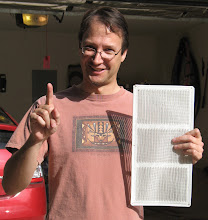Our narrative now winds into the summer of 2008. I had just completed radiant barrier coverage in the attic of a little less than half the house, including a solid section over the east-facing and mostly unshaded master bedroom suite, giving me a very good opportunity to determine whether this formerly hottest area of the house would make a noticeable difference as the fierce Texas summer came on. The other barrier-covered section was west-facing in the attic over the garage.
The first thing that I noticed, as the sun began to warm the house in the summer mornings, was that the air conditioner did not start as early in the morning. In fact, it hardly ran at all before 10 am. This unusual development seemed to indicate that the east-facing "artificial shade" of the radiant barrier was working.
Next, from about 10 am to about 3 pm, the house heated up rapidly. The air conditioner would start to run more and more frequently, as expected, as the barrier located at the eastern and western edges of the house, didn't do much good for blocking the almost directly overhead sun angles. In the late afternoon and early evening I could not tell much difference as the roof and attic were fully heated up, and the air condition ran a lot, although certainly not constantly. The west-facing section may not have helped me as noticeably, first because it was over the garage, and second because I do have partial shade already on the west side of the house.
But how was the feel of the master bedroom, which for more than a decade has been the room that we would avoid in the summer until the last possible moment, due to the heat buildup every single hot day?
The difference was nothing short of dramatic. The hottest area of the house immediately became the coolest area due to the radiant barrier. In fact, for the first few weeks, without ever planning it, we found ourselves retreating to the master bedroom after dinner to read or play on the computer because it was the most comfortable place to be.
Even more amazing was the fact that as the summer wore on and the days got even hotter, we had to RAISE the thermostat setting a degree because the master bedroom was getting too cold. Since the thermostat itself was in an un-barrier-covered part of the house, it was exposed to the full heat load and ran the A/C accordingly. However, the parts of the house not exposed to the full heat load due to the apparently incredible heat-rejection properties of the barrier still received their full measure of cold air from the A/C, dropping the temperature dramatically. I recall at least a 6 or 7 degree difference from the central (uncovered) area to the master bedroom.
These minor miracles were made even more miraculous by the fact that the master bedroom area has two of its four sides as vaulted ceilings, which were inaccessible for installation of the radiant barrier. In other words, this remarkable turnaround from hottest area to coldest area happened with only about 60% radiant barrier coverage of the room. (The only way to get radiant barrier over the sloped part of the vaulted ceilings would be to replace the roof decking with decking that has radiant barrier along the bottom of it, and the only time that it makes any sense at all to do that is when you're replacing a roof (which I in fact did in 2009: foreshadowing!))
In short, the half-done barrier worked incredibly well. The comfort level was immediately noticeable, and resulted in our actually setting the thermostat a degree warmer for that summer. The uneven heating of the house was quite noticeable and caused me a good degree of regret at my late start that winter, and renewed my resolve to complete the barrier over the entire house once the summer heat was gone and the attic was once again safe to work in.
Saturday, October 17, 2009
Subscribe to:
Post Comments (Atom)


No comments:
Post a Comment